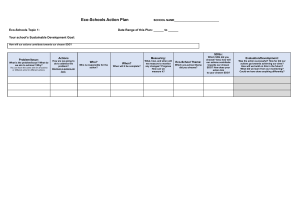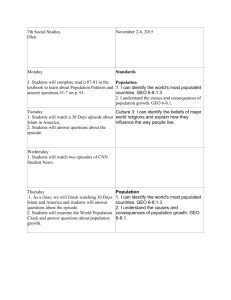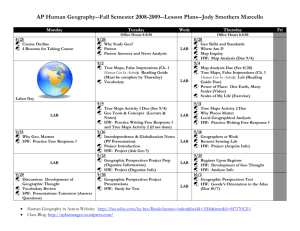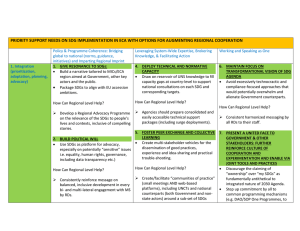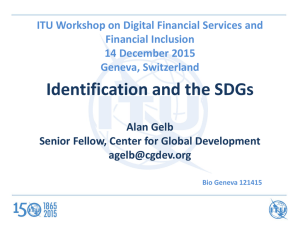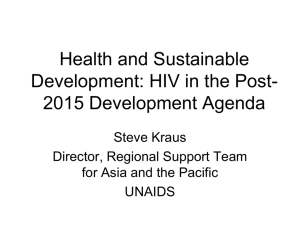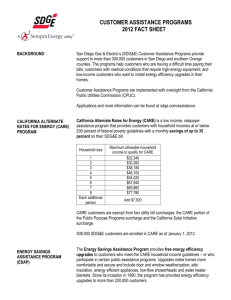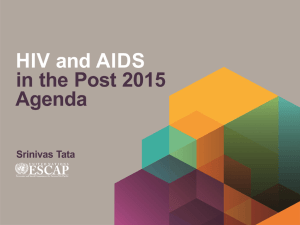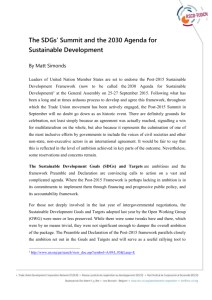Earth observations in SDG water monitoring GEO Plenary XII
advertisement
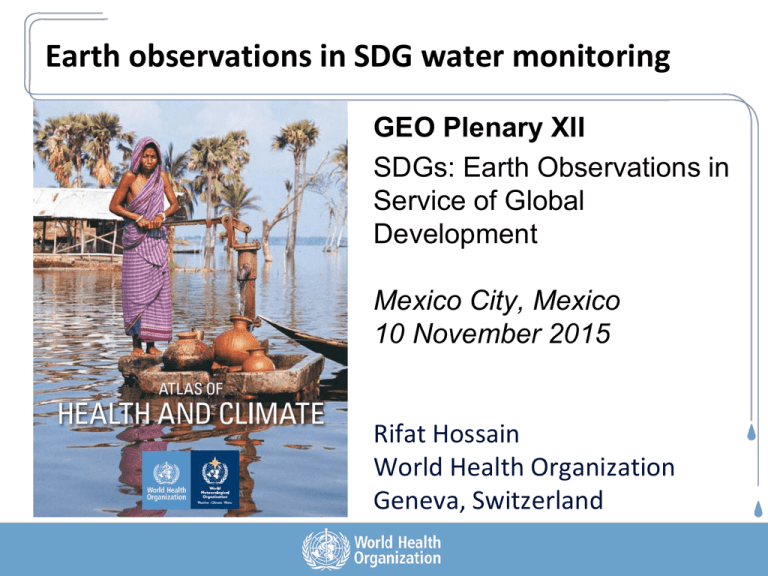
Earth observations in SDG water monitoring GEO Plenary XII SDGs: Earth Observations in Service of Global Development Mexico City, Mexico 10 November 2015 Rifat Hossain World Health Organization Geneva, Switzerland Global goals… • Tool of global governance • Measuring progress for the global community • Informing global investments • Objective: mobilize political support for neglected priorities • MDG experience: mobilized support for development, focused on poverty and human well being • SDG calls for: sustainability (economic, social and environmental) in development under good governance Lessons from MDG monitoring • High focus on development: silent on sustainability etc. • Piggy backing on household surveys • Cost effective • Limit different aspects and timely reporting • Info on access to water sources, but not its quality • Earth observations: • Data available for cost effective monitoring • Huge investments in EO: developed countries contribution to monitoring next goals and targets? • Data revolution: integrate EO, Big Data, traditional data 3 Independent Expert Advisory Group on Data revolution for SDGs • Recognizes use of various data, including novel, geospatial and Big Data, in an integrated manner • An urgent call for action for • • • global consensus on principles, Share technology/innovation for common good New resources for capacity development • Data revolution is a joint responsibility of Governments, international and regional organizations, the private sector and civil society. • Underscores importance of CRVS: denominator issue EO, novel data & data integration EO in SDG water monitoring: a UN initiative WASH (WHO/UNICEF JMP) domestic waste water and reuse WWM & WQ industrial waste water and reuse water quality and reuse water withdrawals and productivity water withdrawals and ecosystems WRM Integrated water resources management 5 Global indicators for SDG water monitoring • 6.1.1 % of population using safely managed drinking water services: • 6.2.1 % of pop using safely managed sanitation services • 6.3.1 % of waste water safely treated • 6.3.2 % of water bodies with good ambient water quality • 6.4.1 % of change in water use efficiency over time • 6.4.2 Level of water stress: freshwater withdrawal in percentage of available freshwater resources • 6.5.1 Degree of integrated water resources management (IWRM) implementation (0-100) • 6.6.1 % change over time in water related ecosystems Task Team Contributors • International: WHO, GEO, WMO, UNU-FLORES, WCRP (GEWEX), WMO-CHY, CIESIN, World Bank, UN Global Pulse • Countries: Australia (CSIRO), Bangladesh, China, Colombia, Japan (MEXT), Germany, Pakistan, USA (USEPA, USGS, NSF, USACE, US GEO), • Space Agencies: ESA, JAXA, NASA, NOAA • Academia and institutes: Chouaib Doukkali University (Morocco), U of Tokyo, Chinese Academy of Sciences, U of Bonn, Vrije Universiteit Amsterdam, University of Twente, CUNY, U of Texas, GMU, Delatres, Fraunhofer Institute of Optronics, WRI • Two members from SG IEAG on data revolution for SD Application of EO in wastewater monitoring IAEG indicator: Proportion of wastewater safely treated EO support for the indicators (pop density, landuse, landcover, etc.) integrated with other geospatial, survey and admin data 1) 2) EO integrated with other geospatial data to estimate waste water generation potential, releases and their impacts. High resolution satellite images can document the location of treatment facilities. Limitations Analytical Soundness Direct Measurability Other SocioEconomic, and Census/Statisti cal Data Relevance Indicator/EO applicability EO + EO-Based Data Assimilation Model Relevance EO applicability for SDG water monitoring 6.1+6.2 WASH Computed as a residual product using EO 6.3 Wastewater and Water Quality For Nitrates, Phosphates and Algae, Phytoplankton Blooms and Sediment 6.4 Water Efficiency Accurate Quantification of Water Use and Type Required 6.5 Water Resource Management 6.6 water ecosystems Associated “management” inputs combined with EO on Water availability/change variables Resolution and accuracy is dependent on type of parameter, data availability and application EO data integration: more than filling gaps… • Indicator framework will place many demands on national statistical systems • Lack of capacity for additional monitoring is acute • Huge cost to support more demanding indicators • Cost effective gains can be made when EO data are considered • WHO/UNICEF JMP-SDSN work on cost effective monitoring of the water sector will be informative for SDG monitoring in general Can help discussions on (some) grey indicators? Food for thought… • EO community support for SDGs is critical • How do we include this? • What should be the role and value add of GEO? • Is GEO initiative sufficient? • An integral element for GEO workplan: GEO flagship, dedicated funding and support • Significant engagements between (G)EO and SDG monitoring to make this work • How do we national government actors supporting SDGs and GEO/GEOSS THANK YOU Use of all available and relevant data is the real data revolution and integrating them into the monitoring framework will be transformational… Rifat HOSSAIN Email: hossainr@who.int
